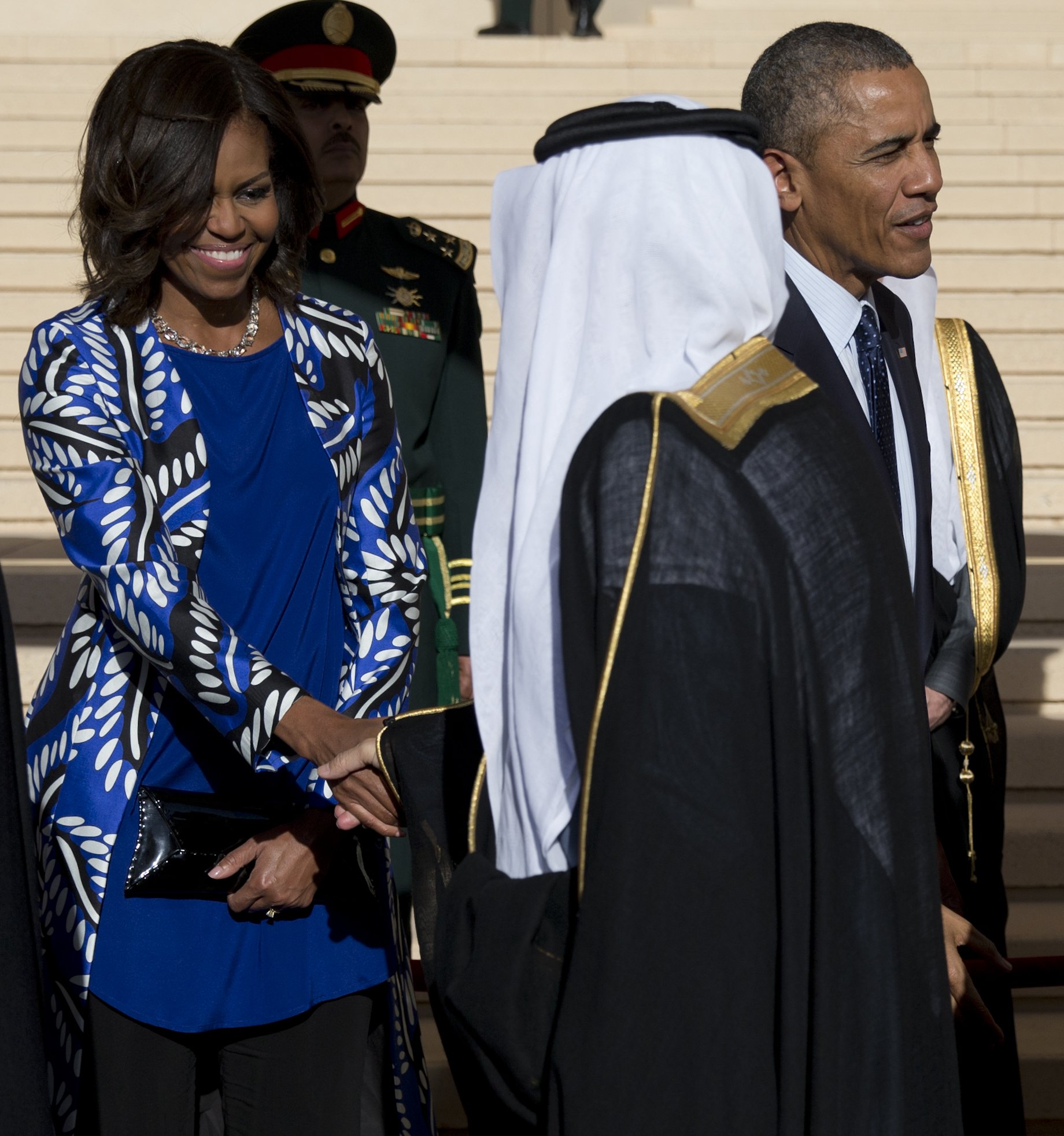
Michelle Obama probably never imagined that one day conservative Texas Senator Ted Cruz would sing her praises. But it happened on Tuesday, when the First Lady stepped out to greet new Saudi leader King Salman without a headscarf.
Obama enjoyed a rare moment of bipartisan praise, as reports floated that Saudi television had blurred her bare-headed visage and that conservative Muslims were taking to Twitter to denounce her sartorial “statement.” But, as these controversies turned out to be greatly exaggerated — even fabricated, in the case of the video — it became increasingly clear that what initially seemed like such a clear-cut issue (freedom of speech! women’s rights! USA!) was far more nuanced. And that, when it comes to perceptions of Saudi culture, we are behind the times.
Consider that in December, a prominent Saudi religious leader — the former head of the ultra-conservative religious police in Mecca — took to social media to announce that he didn’t believe that women needed to cover their faces. (The niqab, or face veil, is by no means Saudi law, but it is a rule enforced by the most hardline Muslims within their communities.) And, more and more frequently, women are shedding their face veils and even head scarves for their Instagram and Twitter pics. Plus, 60% of all college graduates in the country are female (of course, women can’t drive and don’t make as much money as males, but, hey, that latter point is true of America too). So, how strict exactly is the Saudi dress code? How much freedom do women feel that they have? And was the First Lady’s appearance out of line with the dictates and attitudes of the country?
Karen Elliott House, an expert on the region and author of On Saudi Arabia: Its People, Past, Religion, Fault Lines — and Future, explains: “The dress code is strict, but it has become looser in the past ten years, as King Abdullah began to say that women should have more opportunities.” According to Saudi law, all women, Saudis and foreigners alike, are required to wear a full-length cover called an abaya over their clothes, though some (mostly Westerners like the First Lady) can get away with a long coat or tunic. But the rules surrounding headscarves are particularly murky and vary depending on the region or neighborhood (the coastal cities, for example, are more liberal, while the capital remains extremely conservative, with more women wearing the niqab). Technically, women only need to wear a headscarf if their male guardian (either a father, husband, brother, or son) requires it, says House. But, the religious police can stop any female and demand that she cover her hair. “A courageous woman can say, ‘My guardian doesn’t require me to cover [my head],’ but most prefer to avoid trouble and cover their hair, if not their faces.”
“There are certain places — government buildings, schools — where even if you have a scarf on your head but aren’t covering all your hair, the police will ask you to cover up,” says Jasmine Bager, a Saudi journalist who is currently based in New York City. “But, at the same time, a lot of people will go to a restaurant with their head covered, sit down and uncover it, eat their food, and then put their scarf back on when it’s time to leave.”
Yet, when it comes to the Internet, Saudi women can really let their hair down — literally. “When I was younger I thought it [was] an act of rebellion to put your photo online,” says Bager. “But now, it’s normal — people see their friends photos, and they share their own. It’s not a political statement.” Yet, this freedom is obviously helping shift conservative notions of how women should, and should not, dress in public. Indeed, it was a woman on Twitter who prompted Ahmad Aziz Al Ghamdi, that former head of religious police, to reconsider the rules regarding the niqab. And, with Muslim women — from all over the world — taking to Instagram to show off their fashion-forward modest styles, Saudi women are now privy to a host of new ways to use dress, including the headscarf or hijab, as a means of personal expression, religious commitment, and empowerment.
As for Michelle Obama’s outfit, while Americans saw it as an act of defiance, to the vast majority of Saudi women it wasn’t anything shocking or offensive. That may be due to a more relaxed online culture, to a rapidly changing society, or to many women’s comfort with certain aspects of religious dress. “Women are changing Saudi Arabia,” says House, even if, she adds, it’s “slowly.”
More Must-Reads from TIME
- Inside Elon Musk’s War on Washington
- Meet the 2025 Women of the Year
- The Harsh Truth About Disability Inclusion
- Why Do More Young Adults Have Cancer?
- Colman Domingo Leads With Radical Love
- How to Get Better at Doing Things Alone
- Cecily Strong on Goober the Clown
- Column: The Rise of America’s Broligarchy
Contact us at letters@time.com